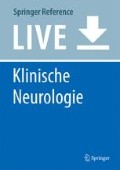Zusammenfassung
Die multiple Sklerose (MS) ist eine der häufigsten neurologischen Erkrankungen, für deren Ursache es bislang keine einheitliche Erklärung gibt. Die MS verläuft anfangs oft schubförmig-remittierend, später dann schubförmig- oder sekundär chronisch-progredient. Die klinischen Symptome sind aufgrund der Krankheitsmanifestation im gesamten zentralen Nervensystem äußerst heterogen. Insbesondere auch kognitive Defizite und das MS-assoziierte Fatigue-Syndrom sind in den letzten Jahren zunehmend in den Fokus der klinischen Forschung gelangt. Zudem werden durch die Möglichkeit einer symptomatischen Behandlung Symptome wie Spastik und autonome Störungen mehr berücksichtigt und wahrgenommen.
Literatur
Achiron A, Barak Y (2003) Cognitive impairment in probable multiple sclerosis. J Neurol Neurosurg Psychiatry 74:443–446
Arnett PA, Rao SM, Bernardin L et al (1994) Relationship between frontal lobe lesions and Wisconsin card sorting test performance in patients with multiple sclerosis. Neurology 44:420–425
Bates D (1994) The diagnosis of multiple sclerosis. In: Proceedings of the MS forum modern management workshop. Professional Postgraduate Services Europe, Worthing
De Seze J, Arndt C, Jeanjean L (2008) Relapsing inflammatory optic neuritis: is it neuromyelitis optica. Neurology 70:2075–2076
De Stefano N, Matthews PM, Filippi M et al (2003) Evidence of early cortical atrophy in MS: relevance to white matter changes and disability. Neurology 60:1157–1162
Gauthier SA, Berger AM, Liptak Z et al (2009) Rate of brain atrophy in benign versus early multiple sclerosis. Arch Neurol 66:234–237
Heckl RW (1994) Multiple Sklerose: Klinik, Differenzialdiagnose, Behandlung. Thieme, Stuttgart
Kesselring J (1997) Multiple sklerose, 3. Aufl. Kohlhammer, Stuttgart (2. Aufl. 1993)
Kis B, Rumberg B, Berlit P (2008) Clinical characteristics of patients with late-onset multiple sclerosis. J Neurol 255(5):697–702
Krupp LB, Alvarez LA, LaRocca NG et al. (1988) Fatigue in multiple sclerosis. Arch Neurol 45:435–437
Poser S, Wikström J, Bauer HJ et al (1979) Clinical data and identification of special forms of multiple sclerosis in 1271 cases studied with a standardized documentation system. J Neurol Sci 40:159–168
Pueyo V, Martin J, Fernandez J et al (2008) Axonal loss in the retinal nerve fiber layer in patients with multiple sclerosis. Mult Scler 14:609–614
Ramsaransing GSM, De Keyser J (2007) Predictive value of clinical characteristics for „benign“ multiple sclerosis. Eur J Neurol 14:885–889
Rocca MA, Colombo B, Falini A et al (2005) Cortical adaption in patients with MS: a cross-sectional functional MRI study of disease phenotypes. Lancet Neurol 4:618–626
Sayao AL, Devonshire V, Tremlett H (2007) Longitudinal follow-up of „benign“ multiple sclerosis at 20 years. Neurology 68:496–500
Schulz D, Kopp B, Kunkel A, Faiss JH (2006) Cognition in the early stage of multiple sclerosis. J Neurol 253:1002–1010
Simon JH, Jacobs LD, Campion MK et al (1999) A longitudinal study of brain atrophy in relapsing multiple sclerosis. The multiple sclerosis collaborative research group. Neurology 53:139–148
Stangel M, Penner IK, Kallmann BA et al (2013) Multiple Sclerosis Decision Model (MSDM): Entwicklung eines Multifaktorenmodells zur Beurteilung des Therapie- und Krankheitsverlaufs bei schubförmiger MS. Akt Neurol 40(09):486–493
Thompson A (2004) Overview of primary progressive multiple sclerosis (PPMS): Similarities and differences from other forms of MS, diagnostic criteria, pros and cons of progressive diagnosis. Mult Scler 10:S2–S7
Vetrugno R, Stecchi S, Scandellari C et al (2007) Sleep-wake and body core temperature rhythms in multiple sclerosis with fatigue. Clinical Neurophys 118:228–234
Weinshenker BC, Bass R, Rice GPA et al (1989) The natural history of multiple sclerosis: a geographically based study. I. Clinical course and disability. Brain 112:133–146
Wingerchuk DM, Banwell B, Bennett JL et al (2015) International consensus diagnostic criteria for neuromyelitis optica spectrum disorders. Neurology 85:177–189
Author information
Authors and Affiliations
Corresponding author
Editor information
Editors and Affiliations
Rights and permissions
Copyright information
© 2019 Springer-Verlag GmbH Deutschland, ein Teil von Springer Nature
About this entry
Cite this entry
Faiss, J. (2019). Multiple Sklerose: Klinik. In: Berlit, P. (eds) Klinische Neurologie. Springer Reference Medizin. Springer, Berlin, Heidelberg. https://doi.org/10.1007/978-3-662-44768-0_158-1
Download citation
DOI: https://doi.org/10.1007/978-3-662-44768-0_158-1
Received:
Accepted:
Published:
Publisher Name: Springer, Berlin, Heidelberg
Print ISBN: 978-3-662-44768-0
Online ISBN: 978-3-662-44768-0
eBook Packages: Springer Referenz Medizin

